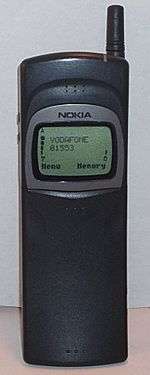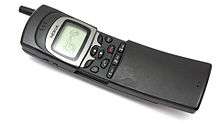Nokia 8110
Nokia 8110 is a mobile phone released in 1996. It was announced on September 9, 1996 as the first of Nokia's high-end 8000 series of phones.[1] Its distinctive styling was the first example of a 'slider' form factor. A sliding cover protected the keypad when being carried in the pocket and extended downwards in use, bringing the microphone closer to the mouth.[2] The action of opening the cover also answered an incoming call. The prominent curvature of the case, particularly when open, earned it the nickname "banana phone". It was also the first Nokia phone with monochrome graphic LCD.
 | |
| Manufacturer | Nokia |
|---|---|
| Compatible networks | GSM-900 |
| Availability by region | Discontinued |
| Successor | Nokia 8810 Nokia 7110 Nokia 8110 4G |
| Related | Nokia 3110 |
| Form factor | Slider |
| Dimensions | 141 x 48 x 25 mm |
| Mass | 145 g |
| Memory | No |
| Removable storage | No |
| Battery | Slim 400 mAh Li-Ion, Extended 900 mAh Li-Ion |
| Display | Monochrome partly-graphic LCD |

The phone was designed for the business market and was one of the smallest and lightest (152 grams) phones on the market, but still had better battery life than its predecessor Nokia 2110.
The improved 8110i model, announced in March 1997, was the first phone with the SSMS (Smart SMS) engine.[3] The handsets could be updated OTA (Over The Air) with an intelligent menu structure, which allowed simple information input, input which was sent through a simple structured text message to an MT receiver. This station could interpret information and a structured text message back to the handset. Ring tone receiving by SMS was also part of the smart messaging protocol, so 8110i was also the first mobile phone to support it. Nokia later stopped marketing Smart messaging and concentrated on the upcoming WAP standard, but has not dropped smart messaging support from later phones. Both models were succeeded by Nokia 8810 in 1998.
Cultural references
An altered version of this phone was famously featured in the science fiction action film The Matrix (1999), for which it was modified featuring spring-loaded mechanism (this actually appeared on the Nokia 7110).[4][5]
Variants
- The Nokia 8146/8148 for the GSM-1800 band.
- The Nokia 3110 shared the same engine.
See also
- Nokia 8110 4G
- Samsung SPH-N270, the phone from The Matrix Reloaded
References
- "The Nokia 8110 - a New Generation Mobile Phone - Nokia". Nokia.
- "The Nokia 8110 - a New Generation Mobile Phone" (Press release). Nokia. 1996-09-09. Retrieved 2018-01-23.
- "Nokia Unveils a Range of New Superior Products at CeBIT'97 -Offering enhanced usability, new products enable fast and easy access to digital cellular services - Nokia". Nokia.
- Phelan, David. "Nokia 8110 4G: The Coolest Secrets Of The New Matrix Banana Phone Revealed By Nokia's Design Elite".
- "Nokia slots itself into The Matrix" (Press release). Nokia. 1996-09-09. Retrieved 2018-01-23.